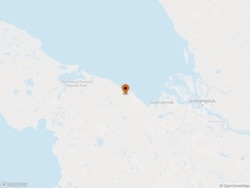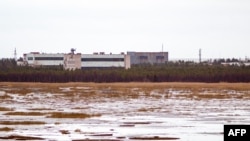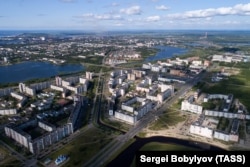Russia's weather-monitoring agency has reported a measurable jump in radiation levels near the Arkhangelsk naval test site where an explosion and fire last week killed at least five people.
An official with Severodvinsk, a shipbuilding port not far from the Nyonoksa test range, said that residents of the village of Nyonoksa would be evacuated for a two-hour window on August 14 in connection with unspecified work at the site. That statement was later contradicted by the regional governor.
The August 13 statement by the Rosgidromet weather agency added further evidence to reports that the test at the Nyonoksa range on the White Sea had released not only toxic missile fuel but also unspecified radioactive material.
The August 8 incident continues to be dogged by confusion and misinformation from local and federal officials, both about the exact death toll but also what exactly was being tested.
The Kremlin on August 13 gave its first statement about the mishap, although spokesman Dmitry Peskov gave little new information about whether the explosion was the result of a test on a new nuclear-powered missile, as some U.S. analysts have pointed to.
"Accidents, unfortunately, happen. These are tragedies. And in this case it is important for us to remember those heroes who lost their lives as a result of these accidents," Peskov was quoted by Russian news agencies as saying.
Residents of the city of Severodvinsk, around 30 kilometers east of Nyonoksa, reportedly bought out iodine drops from city pharmacies in the hours after the first reports emerged; iodine is often taken to protect the thyroid gland from some types of radiation.
In its statement published by the state news agency TASS, Rosgidromet cited data collected by a northern regional monitoring agency, saying that gamma radiation levels jumped by 4 to 16 times normal levels in Severodvinsk on August 8. TASS also quoted an official with the state-run nuclear agency Rosatom as saying the levels were harmless for humans.
An earlier report published on August 8 by Arkhangelsk regional emergency officials said radiation levels had risen to 20 times normal levels. That report was circulated by the environmental group Greenpeace.
The Severodvinsk city administration had also published a statement on August 8 reporting an increase in radiation, though that statement was later taken down from its website.
Russian news media reported that shipping would be restricted in the Dvina Bay, where Nyonoksa and Arkhangelsk are located, for several weeks due to toxic rocket fuel leaking into the water.

The Defense Ministry said initially that two people had died, and six were injured, in the incident, when a liquid-fueled rocket engine exploded, sparking a fire. But there was no mention of any release of radiation.
By August 10, Rosatom announced that five of its employees had been killed, the first official indication that there had been some sort of nuclear component to the tests. Three others were injured, the agency said.
No definitive death toll has been released, and it was unclear whether the Defense Ministry figure included the five cited by Rosatom.
Funerals for those five were held on August 12 in Sarov, a closed scientific research city about 450 kilometers southeast of Moscow.
In a video published on a Sarov news website on August 11, Vyacheslav Solovyov, a nuclear researcher at the main nuclear research facility in Sarov, said the researchers had been investigating, among other things "the creation of small-scale sources of energy using radioactive fissile materials."
U.S. analysts have focused on a possible nuclear-powered cruise missile that was being tested, something that President Vladimir Putin last year announced was under development.
In a post to Twitter on August 12, U.S. President Donald Trump also asserted the incident was a failed test of a missile prototype nicknamed Skyfall by NATO experts, though he gave no evidence.
The scattered and contradictory information about what exactly happened has led to speculation in and out of Russia that the mishap was far worse than officials have revealed.
The RIA-Novosti news agency quoted Ksenia Yudina, a spokeswoman for the Severodvinsk city administration, as saying that residents of Nyonoksa would be evacuated by special train for a two-hour period -- from 5 a.m. to 7 a.m. -- on August 14, for what she called “planned military activity” at the test site.
No further explanation was given as to the work involved, or why the evacuation of the town was limited to a two-hour window. That recommendation was later rescinded, Interfax news agency reported.
An e-mail sent by RFE/RL to the city administration was not immediately returned.
Yudina's statement was later contradicted by the governor for the Arkhangelsk region, Igor Orlov.
"There is no evacuation," he was quoted by Interfax as saying.
In its latest statement on the incident, Norway's radiation-monitoring agency on August 12 said that it hadn't recorded any uptick in radiation levels by its monitoring equipment. Norway shares a border with Russia on the Kola Peninsula, some 700 kilometers to the northeast of Severodvinsk.














